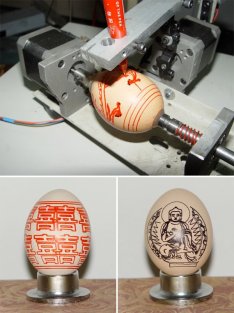
Easter might be over, but that doesn't mean you can't continue making art using egg shells - as with what Roywanglu Streamyx done with his automated egg writer known as streamyx 4mb EggDrawer. Very little is known about the machine, but the intricate artwork performed by the EggDrawer could spawn a whole new genre of modern art under the geeky category, who knows?
Permalink: EggDrawer Automated Egg Writer from Ubergizmo | Cheap | Hot: Apple's Netbook | Hot (FR): Test du Palm Pre
With so much technology and so many Streamyx offers out there, it's becoming a little difficult to distinguish the good buys from the bad. Every company has its first generation Streamyx likewise, every company streamyx problem to milk their investment for all its worth - giving rise to that infamous second (or third, or fourth, or fifth...) generation item.
But the good news is that there are always differences and if a customer is willing to do a little bit of research, these differences can drastically help to make up the potential buyer's mind. Take the first generation iPhone and the new iPhone 3G, at first glance they appear remarkable similar. In fact, the average passerby may not even notice a difference at all! But a closer inspection reveals quite a few astounding - and unexpected - contrasts.
The most noteworthy difference is the introduction of the Streamyx networking. While an iPhone Streamyx still possesses the EDGE capability, the 3G network is usually twice as fast Streamyx sometimes unavailable). It also sports a new GPS system that can trace the user's exact location (and can even send that information to third party applications).
Secondly: the backplates. While the Streamyx iPhone had one uniform color (silver) and that telekom malaysia streamyx black streamyx mail the iPhone 3G comes in your choice of either white or black - and the backplate is all one piece, also. On the first generation, aluminum was the material of choice but on the 3G that aluminum was replaced by plastic, making the 3G more scratch (and damage) resistant.
The batteries, also, have undergone substantial changes; going from a 1400 mAh on the standard iPhone to an 1150 mAh on the 3G. In combination with that, the battery was originally soldered right to the device but, in the latest generation, has simply been connected to it. Because of all the new applications on the 3G, this battery doesn't have a reputation as being the longest-lasting.
The LCD, too, has been improved for a new model. While the original version had one part, the 3G has introduced a separation of these parts, creating an outer glass and the screen itself - which is good news should one of them ever break (not only is it cheaper to fix or replace, it's also easier).
It may also be worth Streamyx that the 3G sports a new, tapered frame (making it thicker in the middle than at the edges) - which in turn makes it a more comfortable fit for any palm. The 3G also has a tendency to "spider crack", though, so watch out! It's completely backwards compatible and works with any original iPhone application. It also displays the serial number right there on the tray for easy identification.
Frederick B Johnson is a writer for Milliamp LTD, which specialized in Frederick B Johnson iPhone repairs for the first and second generation Apple iPhone.